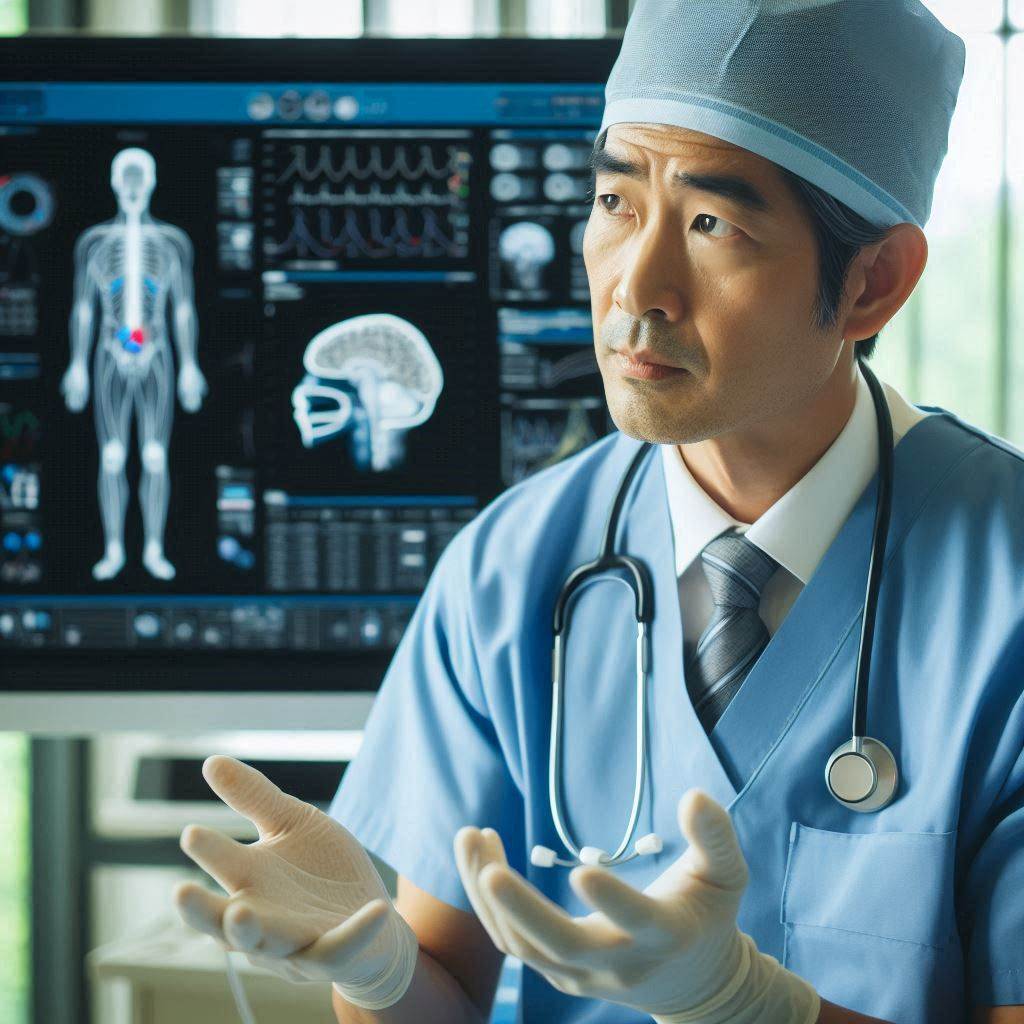Introduction
Nuclear Medicine Technologists (NMTs) are healthcare professionals who play a critical role in diagnosing and treating diseases through the use of radioactive materials.
Their expertise lies in preparing and administering radiopharmaceuticals, conducting imaging procedures, and ensuring patient safety while interpreting complex medical data.
NMTs operate sophisticated imaging equipment, such as gamma cameras and PET scanners, to capture detailed images of organs and tissues, aiding physicians in making accurate diagnoses and determining the effectiveness of treatments.
The primary responsibilities of NMTs include preparing radioactive drugs and administering them to patients, ensuring precise imaging and diagnostic accuracy.
They carefully monitor the patients to track the distribution and concentration of the radiopharmaceuticals within the body, generating images that highlight abnormalities such as tumors, fractures, or infections.
NMTs also analyze the resulting images, providing crucial insights to physicians for diagnosis and treatment planning.
Their role demands a deep understanding of radiopharmacy, anatomy, and radiation safety protocols, alongside strong technical skills to operate advanced imaging equipment effectively.
NMTs typically work in a variety of healthcare settings, including hospitals, diagnostic laboratories, outpatient imaging centers, and research institutions. The work environment is predominantly clinical, characterized by its fast-paced and dynamic nature.
Within these settings, NMTs collaborate closely with radiologists, physicians, and other medical professionals to deliver high-quality patient care.
The job often requires adherence to strict safety regulations to protect both the technologist and the patient from unnecessary radiation exposure.
A standard day in the life of an NMT involves handling radioactive materials, performing imaging procedures, and maintaining imaging equipment.
This requires meticulous attention to detail and a strong commitment to patient safety.
Given the specialized nature of their work, NMTs must remain updated with the latest advancements in nuclear medicine technology and practices, ensuring they provide the most accurate and effective diagnostic services possible.
Work Setting
Nuclear Medicine Technologists (NMTs) play a vital role in the healthcare system, working in various settings that cater to different aspects of patient care and medical research.
Understanding the environments where NMTs operate is crucial for appreciating the scope and impact of their work.
The primary work settings for NMTs include hospitals, outpatient imaging centers, and research facilities.
Hospitals
Hospitals are the most common work environment for Nuclear Medicine Technologists. In this setting, NMTs are integral to the diagnostic and therapeutic processes.
They collaborate closely with radiologists, physicians, and other healthcare professionals to conduct imaging procedures that help diagnose conditions such as cancer, heart disease, and neurological disorders.
The hospital environment is dynamic and fast-paced, requiring NMTs to be adaptable and proficient in handling various types of nuclear imaging equipment.
They often work in specialized departments such as cardiology or oncology, where their expertise in nuclear medicine is essential for accurate diagnosis and treatment planning.
Transform Your Career Today
Unlock a personalized career strategy that drives real results. Get tailored advice and a roadmap designed just for you.
Start NowOutpatient Imaging Centers
Outpatient imaging centers provide a more focused and sometimes less hectic environment for Nuclear Medicine Technologists.
These centers cater to patients who require diagnostic imaging services without the need for hospital admission.
NMTs in outpatient settings perform a range of nuclear imaging procedures, including PET scans and bone scans, in a more scheduled and predictable manner.
The work here allows for a closer patient-technologist relationship, as NMTs often spend more time explaining procedures and ensuring patient comfort.
Outpatient centers typically operate during regular business hours, offering a more structured work-life balance compared to hospital settings.
Research Facilities
For those NMTs interested in the advancement of medical science, research facilities offer a unique and intellectually stimulating environment.
In these settings, NMTs contribute to the development of new imaging techniques and radiopharmaceuticals.
They work alongside scientists and researchers to conduct clinical trials and studies aimed at improving diagnostic accuracy and treatment efficacy.
The role of an NMT in a research facility is often more specialized and focused on innovation, requiring a deep understanding of both current technologies and emerging trends in nuclear medicine.
In fact, the work environment of Nuclear Medicine Technologists varies significantly across hospitals, outpatient imaging centers, and research facilities, each offering unique challenges and opportunities for professional growth.
Read: How to Build a Strong Resume as a Surgical Technologist
Daily Responsibilities
As a Nuclear Medicine Technologist, your work environment can vary depending on the setting in which you work.
Whether you are in a hospital, imaging center, or research facility, your daily responsibilities will typically include:
Preparing radioactive drugs for administration
One of the primary responsibilities of a Nuclear Medicine Technologist is preparing radioactive drugs for administration to patients.
This process requires precision and careful attention to detail to ensure the safety and efficacy of the drugs.
Administering radioactive drugs
Once the radioactive drugs are prepared, Nuclear Medicine Technologists are responsible for administering them to patients.
This may involve injecting the drugs intravenously or orally, depending on the specific procedure being performed.
Operating imaging equipment
Nuclear Medicine Technologists are trained to operate a variety of imaging equipment, including gamma cameras and PET scanners.
They must ensure that the equipment is functioning properly and that images are captured accurately.
Monitoring patients during procedures
During imaging procedures, Nuclear Medicine Technologists are responsible for monitoring patients to ensure their safety and comfort.
Transform Your Career Today
Unlock a personalized career strategy that drives real results. Get tailored advice and a roadmap designed just for you.
Start NowThey must be prepared to address any complications or adverse reactions that may arise during the procedure.
Overall, the work environment of a Nuclear Medicine Technologist is fast-paced and dynamic, requiring a combination of technical skills, medical knowledge, and interpersonal communication abilities to successfully perform their daily responsibilities.
Read: Mental Health Counselor vs. Psychologist: Differences

Interactions with Patients
Nuclear medicine technologists play a crucial role in healthcare, particularly in diagnosing and treating diseases using radioactive materials.
Their work environment is dynamic and patient-centered, demanding a high level of technical expertise and interpersonal skills.
A key aspect of their job involves direct interactions with patients, ensuring procedures are understood, concerns are addressed, and comfort and safety are prioritized.
Explaining Procedures to Patients
One of the primary responsibilities of nuclear medicine technologists is to explain procedures to patients.
This involves breaking down complex medical terminology into understandable language.
Patients often undergo nuclear medicine procedures like PET scans or bone scans without prior knowledge of what these entail.
Technologists must clearly articulate the purpose, process, and expected outcomes of these procedures.
By doing so, they help alleviate any fears or uncertainties, ensuring patients are well-informed and mentally prepared.
Addressing Patient Concerns
Patients undergoing nuclear medicine procedures frequently have concerns, particularly about the use of radioactive materials.
Technologists must be adept at addressing these worries, providing accurate information about the safety and necessity of the procedure.
This involves listening actively to patient questions, offering reassurances, and sometimes dispelling myths or misconceptions.
By effectively addressing concerns, technologists build trust and confidence, which is crucial for the patient’s overall experience.
Ensuring Patient Comfort and Safety
Ensuring patient comfort and safety is paramount in the nuclear medicine technologist’s work environment.
This includes physical comfort, such as positioning patients correctly on scanning equipment, and emotional comfort, by creating a calm and supportive atmosphere.
Safety is another critical aspect, given the use of radioactive substances.
Technologists must adhere to strict safety protocols to protect both the patient and themselves from unnecessary radiation exposure.
They also monitor patients closely during procedures to promptly address any adverse reactions or discomfort.
Transform Your Career Today
Unlock a personalized career strategy that drives real results. Get tailored advice and a roadmap designed just for you.
Start NowIn short, the interactions between nuclear medicine technologists and patients are integral to the successful execution of nuclear medicine procedures.
Through clear communication, addressing concerns, and prioritizing comfort and safety, technologists ensure a positive and effective patient experience.
Read: Medical Technologist vs Clinical Lab Scientist
Team Collaboration
As a nuclear medicine technologist, team collaboration is a crucial aspect of daily work responsibilities.
Working closely with radiologists and other healthcare professionals is essential for providing quality patient care and accurate diagnosis.
Collaboration with Radiologists and Healthcare Professionals
Nuclear medicine technologists often work in close collaboration with radiologists.
Radiologists are physicians who interpret medical images and provide diagnostic information to help guide patient care.
By working together, nuclear medicine technologists and radiologists can ensure that imaging studies are performed accurately and that findings are communicated effectively to the healthcare team.
Communication of Findings
One of the primary responsibilities of a nuclear medicine technologist is to communicate findings from imaging studies to the healthcare team.
This includes sharing information with radiologists, referring physicians, and other healthcare professionals involved in the patient’s care.
Effective communication is essential for ensuring that accurate diagnoses are made and appropriate treatment plans are implemented.
Collaboration with Colleagues
Nuclear medicine technologists also collaborate with their colleagues within the imaging department to ensure that imaging results are accurate and reliable.
This collaboration may involve working with other technologists, nurses, and support staff to coordinate patient care, perform imaging studies, and maintain equipment.
By working together, nuclear medicine technologists can provide efficient and high-quality care to patients.
Team Meetings and Consultations
Team collaboration often involves participating in team meetings and consultations to discuss patient cases, review imaging results, and coordinate care plans.
During these meetings, nuclear medicine technologists may share their findings, ask questions, and provide input to help guide patient care.
By actively participating in team meetings, nuclear medicine technologists can contribute to the overall success of patient treatment and outcomes.
Education and Training
Effective team collaboration also involves ongoing education and training to stay current with advancements in nuclear medicine technology and imaging techniques.
By attending continuing education courses, workshops, and conferences, nuclear medicine technologists can enhance their skills, expand their knowledge, and improve their ability to collaborate effectively with colleagues.
Continuous learning is essential for providing the highest level of patient care and ensuring that imaging results are accurate and reliable.
Transform Your Career Today
Unlock a personalized career strategy that drives real results. Get tailored advice and a roadmap designed just for you.
Start NowOverall, team collaboration is a vital component of the work environment for nuclear medicine technologists.
By working closely with radiologists and other healthcare professionals, communicating findings effectively, and collaborating with colleagues, nuclear medicine technologists can provide high-quality care to patients and contribute to positive patient outcomes.
Read: How Nuclear Medicine Technologists Help Patients
Safety Protocols
Nuclear medicine technologists play a crucial role in diagnosing and treating various medical conditions using radioactive materials.
Their work environment is unique and requires adherence to stringent safety protocols to ensure the well-being of both patients and staff.
Following strict safety guidelines for handling radioactive materials
Handling radioactive materials is a significant part of a nuclear medicine technologist’s daily duties.
Strict safety guidelines are in place to protect technologists and others from radiation exposure.
These guidelines include wearing protective clothing, using shielding devices, and maintaining a safe distance from radioactive sources.
Technologists are also trained to use radiation detection instruments to monitor exposure levels continuously.
Ensuring proper disposal of radioactive waste
Proper disposal of radioactive waste is essential to prevent environmental contamination and health risks
Nuclear medicine technologists must follow established protocols for the disposal of radioactive materials.
This includes segregating radioactive waste from regular waste, using designated disposal containers, and following regulatory requirements for waste storage and disposal.
Technologists must stay informed about changes in disposal regulations to ensure compliance and safety.
Minimizing radiation exposure for patients and staff
Minimizing radiation exposure is a top priority in nuclear medicine.
Technologists are responsible for ensuring that radiation doses are kept as low as reasonably achievable (ALARA) for both patients and staff.
This involves meticulous planning and execution of procedures, using the lowest effective dose of radioactive materials, and employing advanced imaging techniques that reduce exposure.
Additionally, technologists educate patients about the procedures and safety measures in place to alleviate any concerns about radiation exposure.
In a nutshell, the work environment of a nuclear medicine technologist is defined by a commitment to safety.
By following strict guidelines for handling radioactive materials, ensuring proper disposal of radioactive waste, and minimizing radiation exposure, technologists protect themselves, their colleagues, and their patients.
Their adherence to these protocols is essential for maintaining a safe and effective healthcare setting.
Transform Your Career Today
Unlock a personalized career strategy that drives real results. Get tailored advice and a roadmap designed just for you.
Start NowTechnological Advances
The role of a Nuclear Medicine Technologist is both dynamic and demanding, heavily influenced by continuous technological advances.
Staying abreast of these innovations is crucial for delivering high-quality patient care and ensuring accurate diagnostic outcomes.
Staying Updated on New Imaging Technologies
In the rapidly evolving field of nuclear medicine, technologists must remain informed about the latest imaging technologies.
These advancements enhance the ability to diagnose and treat various conditions with greater precision.
For instance, the integration of hybrid imaging systems like PET/CT and SPECT/CT combines functional and anatomical imaging, providing a comprehensive view of the body.
Technologists must understand the capabilities and applications of these technologies to maximize their benefits for patient care.
Training on New Equipment and Procedures
Ongoing training is essential for Nuclear Medicine Technologists to effectively utilize new equipment and procedures.
This training often involves hands-on sessions, workshops, and continuing education courses.
By gaining proficiency in operating advanced imaging systems and implementing new protocols, technologists can enhance their skill set and improve diagnostic accuracy.
Additionally, manufacturers frequently update equipment software, requiring technologists to stay current with these changes to maintain optimal performance and ensure patient safety.
Adapting to Changes in the Field of Nuclear Medicine
The field of nuclear medicine is characterized by constant innovation, necessitating adaptability among technologists.
As new research and clinical trials introduce novel radiopharmaceuticals and imaging techniques, technologists must be flexible and open to integrating these advancements into their practice.
This adaptability extends to collaborating with other healthcare professionals, as the multidisciplinary nature of nuclear medicine often requires technologists to work closely with radiologists, oncologists, and cardiologists to provide comprehensive patient care.
Basically, the work environment for Nuclear Medicine Technologists is deeply intertwined with technological advances.
Staying updated on new imaging technologies, continuously training on new equipment and procedures, and adapting to changes in the field are essential components of their role.
By embracing these elements, technologists can ensure they remain at the forefront of medical innovation, ultimately enhancing patient outcomes and advancing the field of nuclear medicine.
Work Environment Challenges
High-stress situations
Working as a Nuclear Medicine Technologist presents unique challenges that demand both physical endurance and mental fortitude.
One of the most significant challenges is navigating high-stress situations.
Technologists often work with critically ill patients, requiring precise imaging for accurate diagnosis.
The pressure to perform flawlessly under these circumstances is immense, as any error can lead to misdiagnosis or inadequate treatment, directly impacting patient outcomes.
Transform Your Career Today
Unlock a personalized career strategy that drives real results. Get tailored advice and a roadmap designed just for you.
Start NowLong hours on your feet
Another notable challenge is the physical toll of the job. Long hours on your feet are a common aspect of this profession.
Technologists spend extensive periods standing, moving equipment, and positioning patients for scans.
This physical demand can lead to fatigue, making it essential for professionals in this field to maintain good physical health and stamina.
Exposure to radiation
Exposure to radiation is an inherent risk in the work environment of a Nuclear Medicine Technologist.
Despite stringent safety protocols and protective measures, the consistent exposure necessitates vigilance and adherence to safety guidelines to minimize risks.
Regular monitoring and use of personal protective equipment (PPE) are crucial to ensuring long-term health and safety in this high-risk environment.
Importance of maintaining focus and attention to detail
Maintaining focus and attention to detail is critical in this profession. The intricate nature of nuclear imaging requires technologists to be meticulous in their work.
They must ensure the correct dosage of radiopharmaceuticals, accurately position patients, and monitor imaging equipment closely.
A lapse in concentration can lead to significant errors, compromising the quality of diagnostic information and patient safety.
All in all, the work environment of a Nuclear Medicine Technologist is challenging yet rewarding.
The high-stress situations, long hours on your feet, exposure to radiation, and the necessity for unwavering focus and attention to detail require a unique blend of skills and resilience.
Those who thrive in this field do so by embracing these challenges and consistently striving for excellence in patient care and diagnostic precision.
Conclusion
Nuclear Medicine Technologists work in hospitals, clinics, and imaging centers.
They play a vital role in diagnosing and treating various medical conditions.
If you have a passion for healthcare and technology, consider a career in nuclear medicine technology.
It offers a rewarding and fulfilling opportunity to make a difference in patient care.
Join this dynamic field and contribute to the advancement of healthcare technology.
Nuclear Medicine Technologists are essential members of the healthcare team.
Their expertise and skills are critical in providing accurate diagnostic information.
Consider exploring this field and make a positive impact on patient outcomes.
Transform Your Career Today
Unlock a personalized career strategy that drives real results. Get tailored advice and a roadmap designed just for you.
Start NowChoose a career path that challenges you and allows you to grow professionally.
Take the next step towards a rewarding career in nuclear medicine technology.
Become a part of a specialized healthcare profession that is in high demand.




